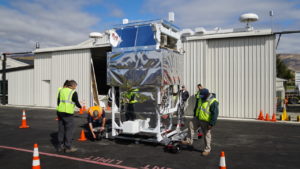How many people does it take to unpack a 5,240-pound NASA balloon?
In preparation for NASA’s next Super Pressure Balloon flight from Wanaka, New Zealand, NASA’s balloon team unpacked the top and bottom fittings of the balloon March 17 to perform test and integration work prior to launch.
The 18.8-million-cubic-foot (532,000-cubic-meter) balloon is enormous – about the size of a football stadium – when fully inflated. The balloon’s inflated shape is an oblate spheroid, or less technically, it’s the shape of a pumpkin. The fittings are essentially the north and south poles of the spheroid. The top fitting has valves where inflation tubes are connected to the balloon. The bottom fitting connects to a parachute, and then the parachute connects to the balloon gondola, which houses the payload and supporting instruments.
Given that the balloon is made of 22 acres (8.9 hectares) of polyethylene film and weighs 5,240 pounds (2,377 kilograms), unpacking the balloon is not a trivial activity. Nearly a dozen technicians working different functions carefully opened up the steel-plate-lined shipping box containing the balloon. From there, an overhead crane was used to lift the fittings out while the team worked along either side of the balloon to keep the film safe during the overall operation.

NASA is currently targeting no earlier than March 25 for launch. The 2017 mission is a continuation of efforts to test and validate the SPB technology, a technology that could significantly expand flight opportunities for missions requiring long duration flights with day/night exposure in a flight regime that closely mimics space. In addition, the balloon team will fly a fluorescence detector and supporting technologies for the University of Chicago’s Extreme Universe Space Observatory, a high-energy cosmic ray particle astrophysics payload. This suborbital flight is a precursor for a mission being planned to launch the EUSO telescope to and install it on the International Space Station (ISS).
Read more about the EUSO-SPB team and their mission at their blog site here: http://astroserve.mines.edu/euso_spb/Blog.html



























